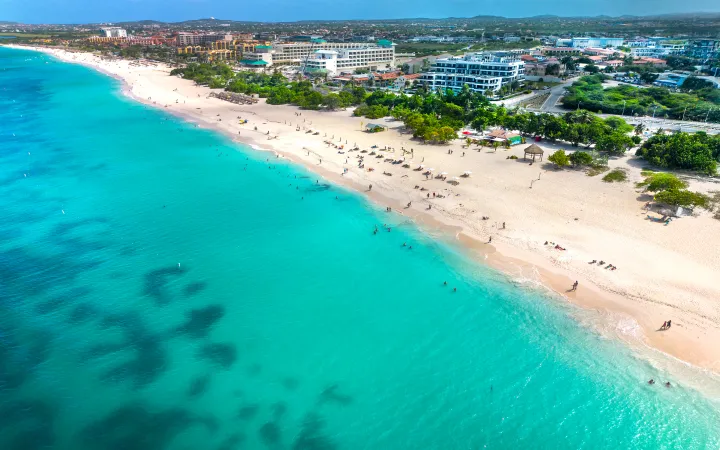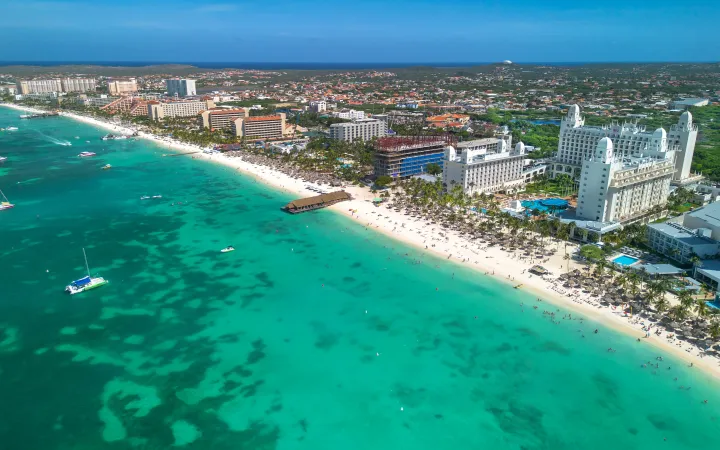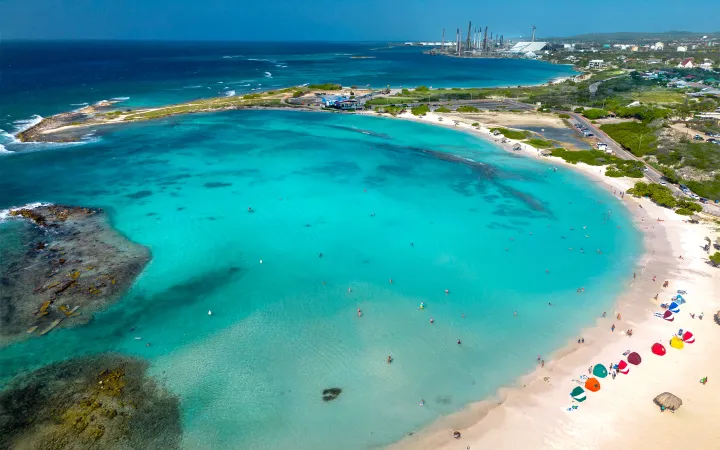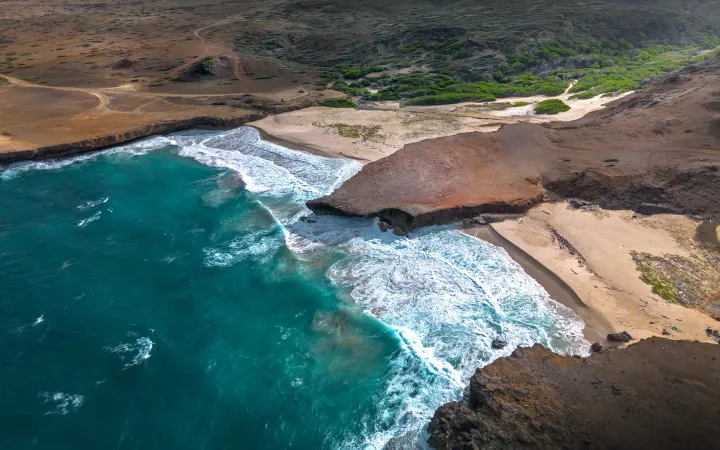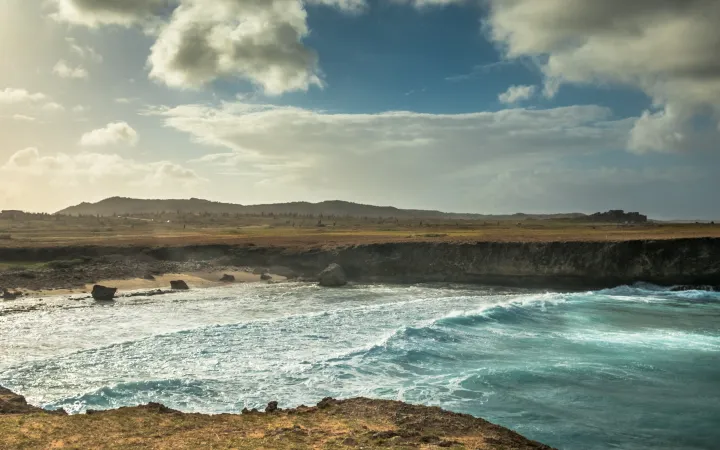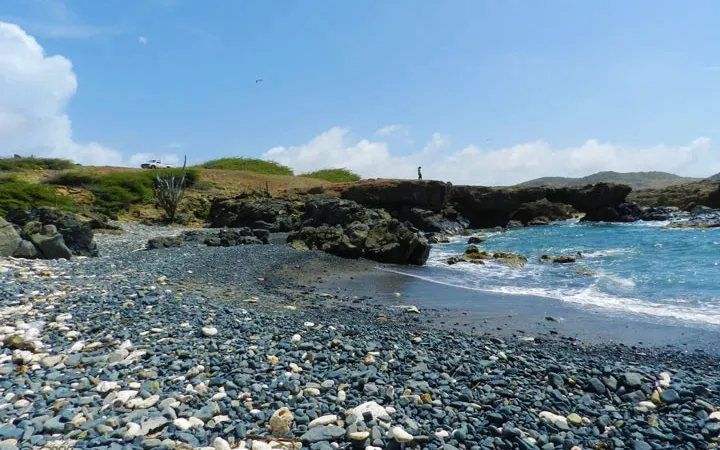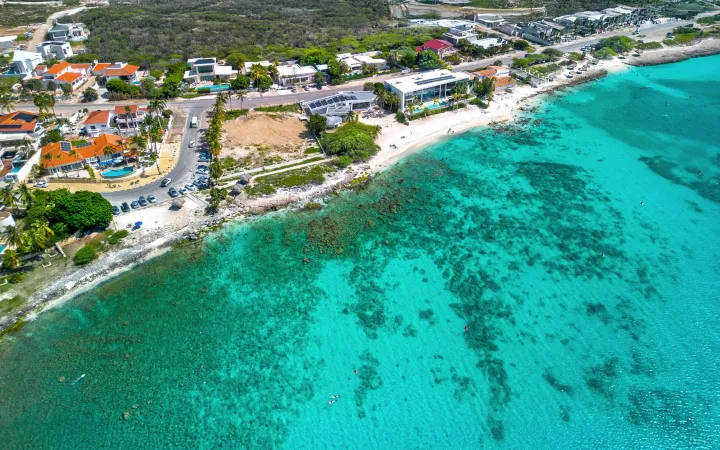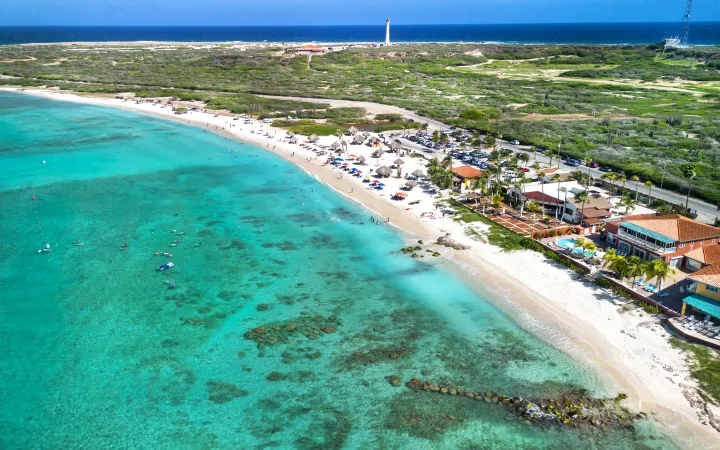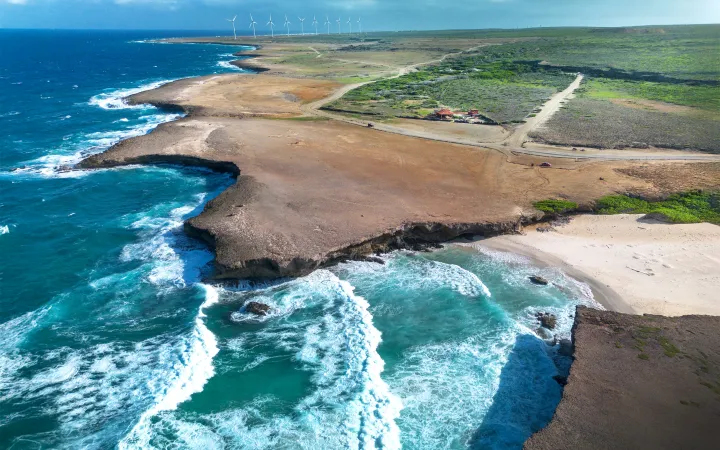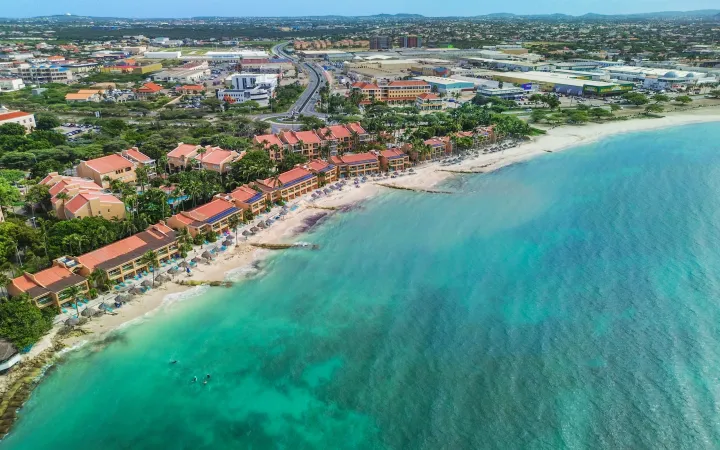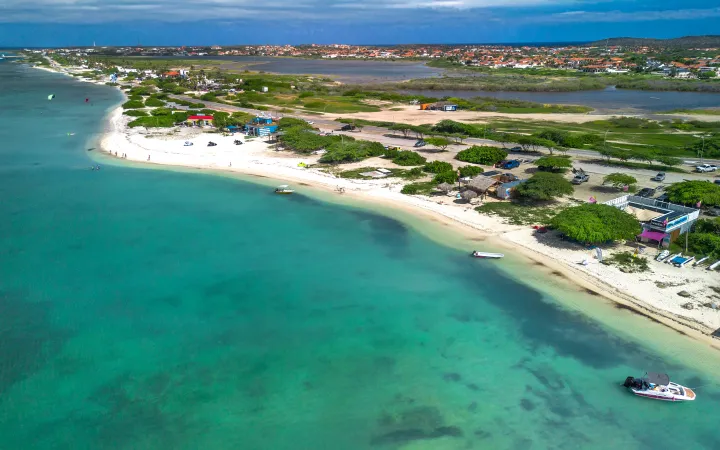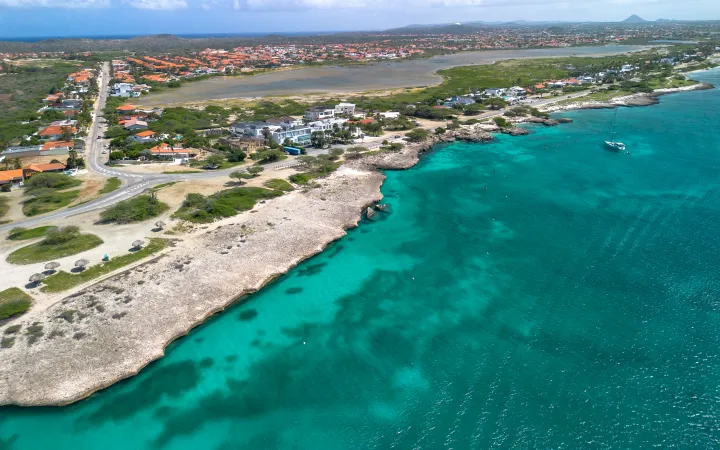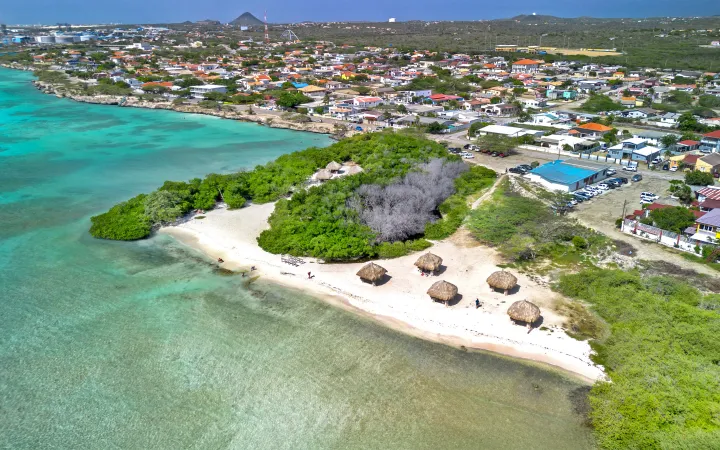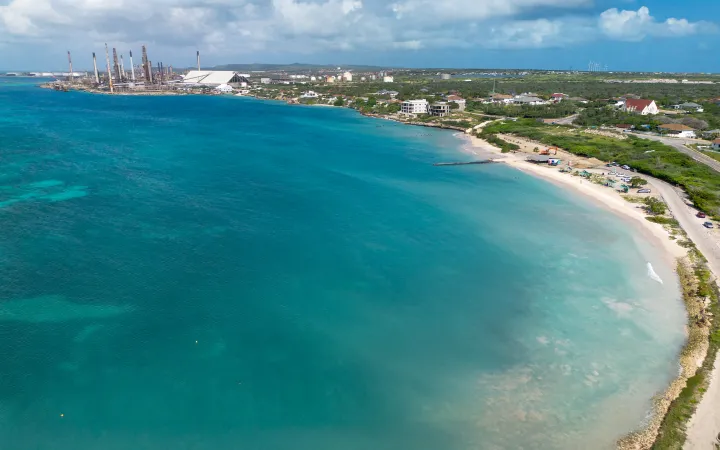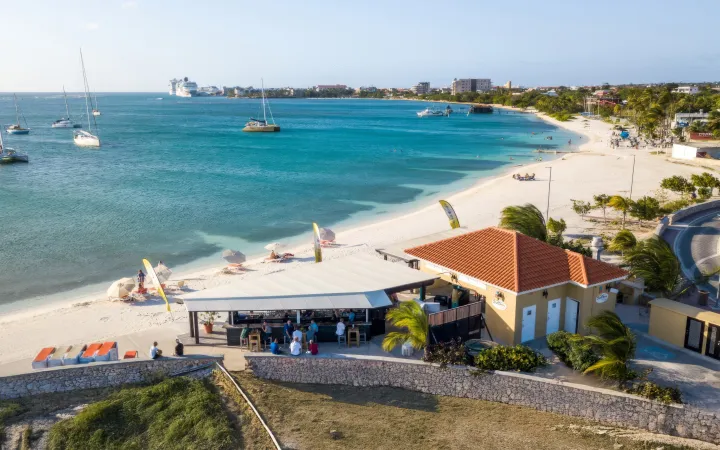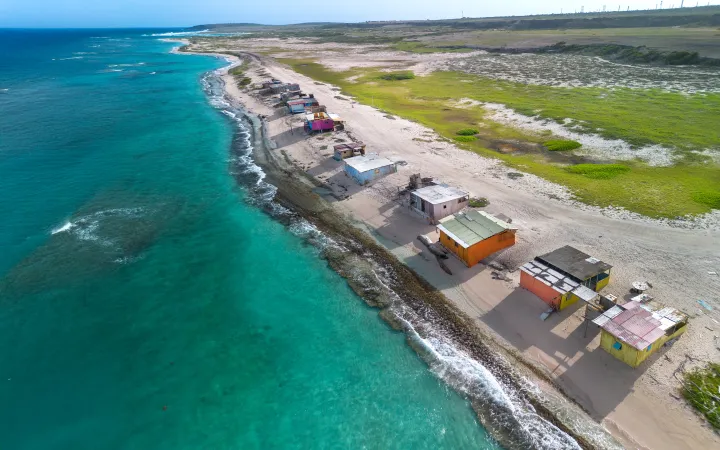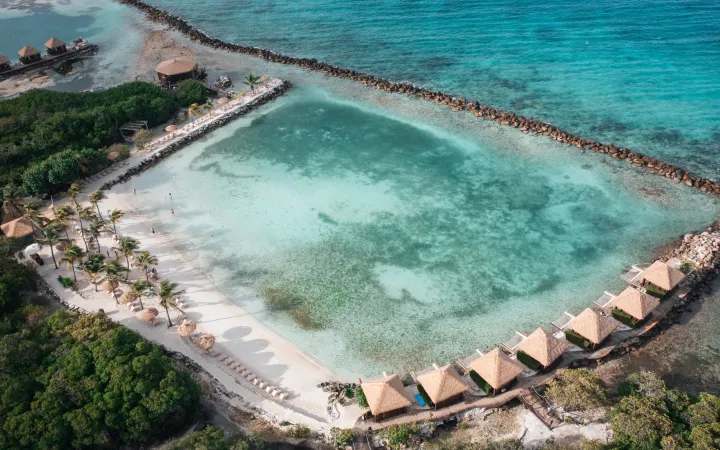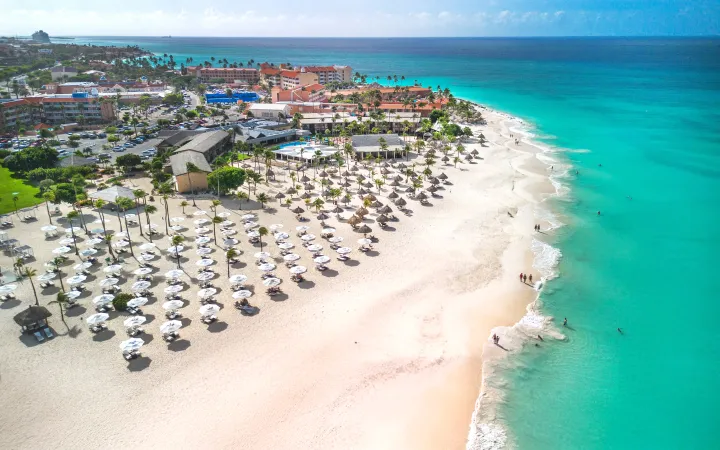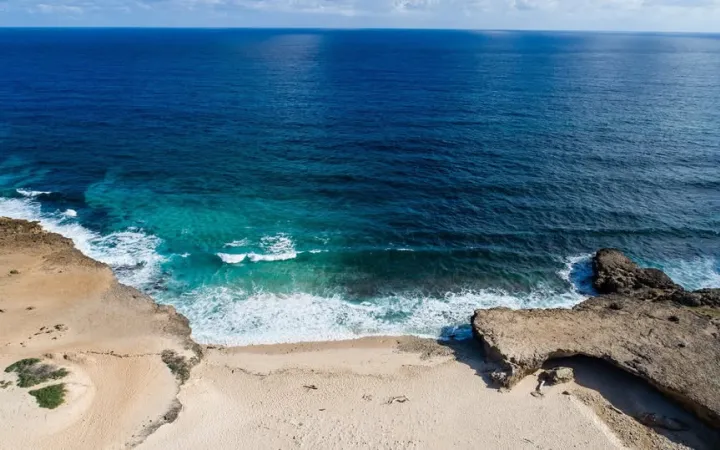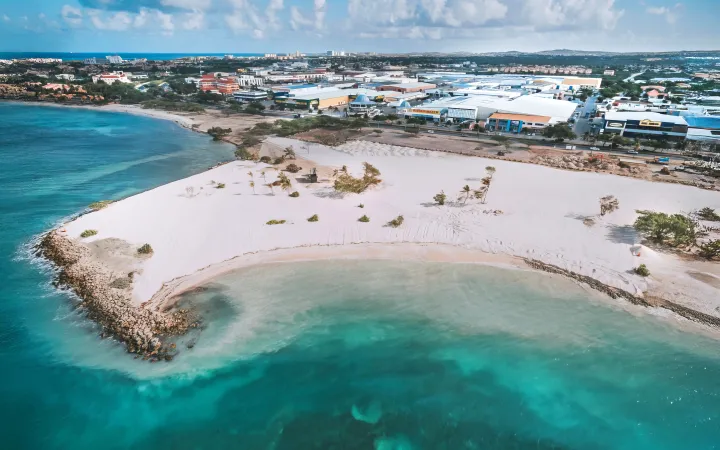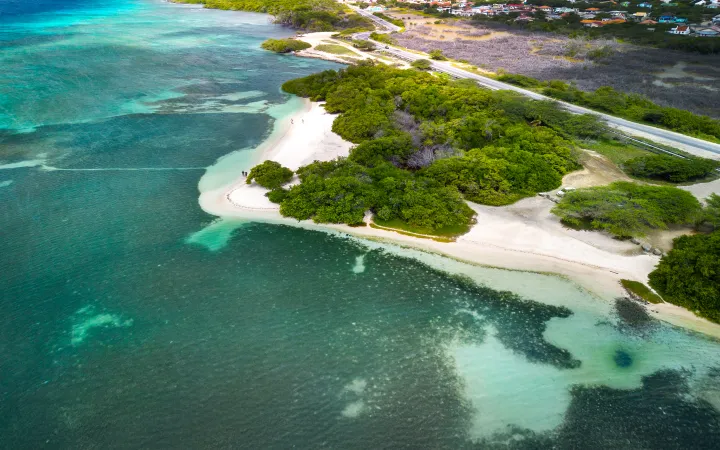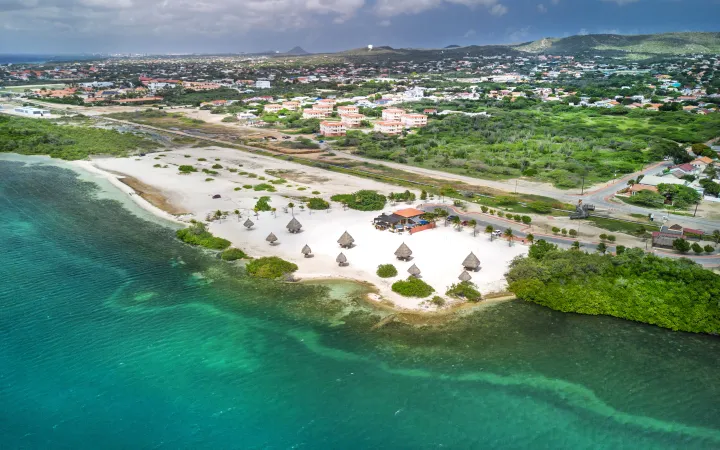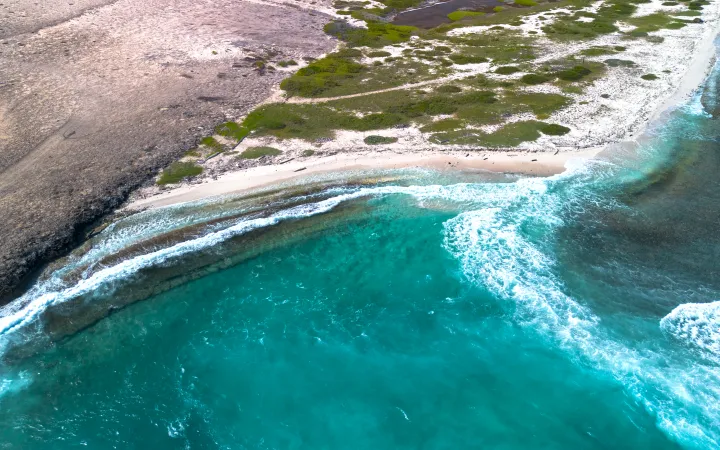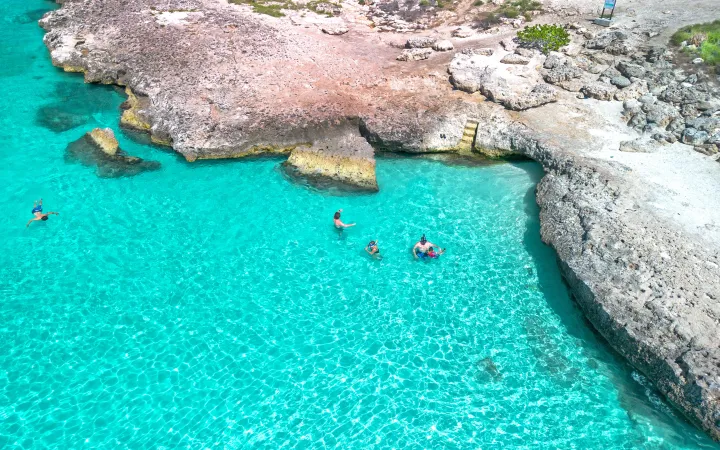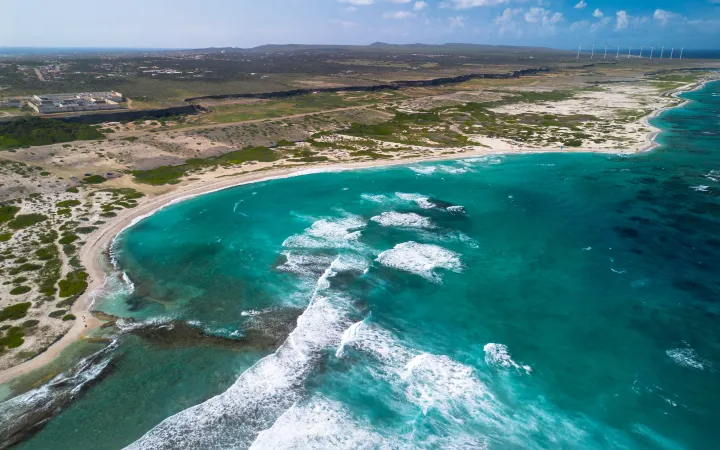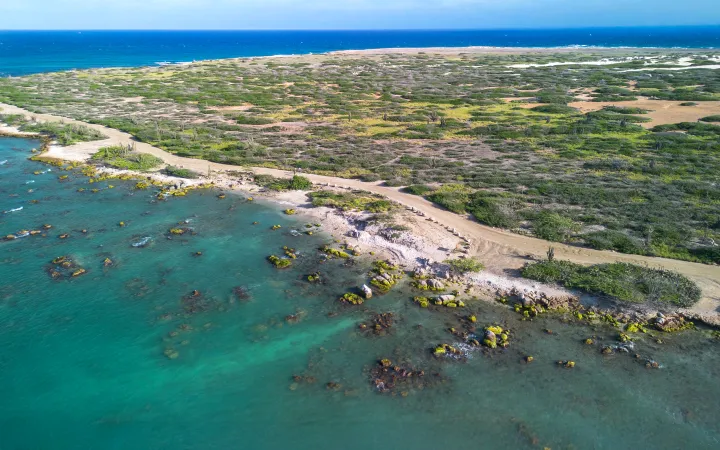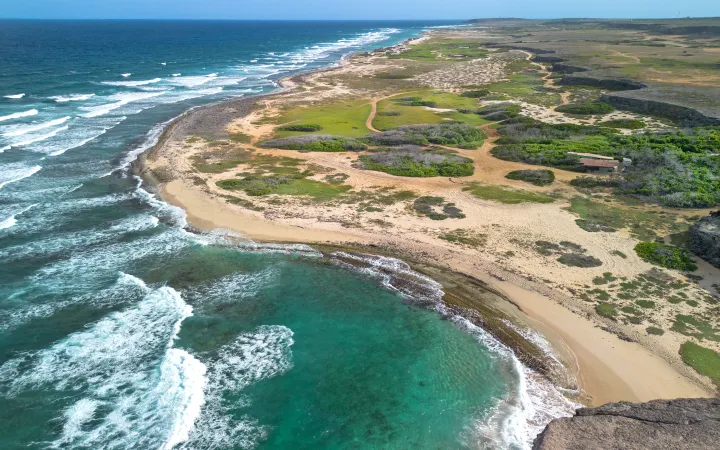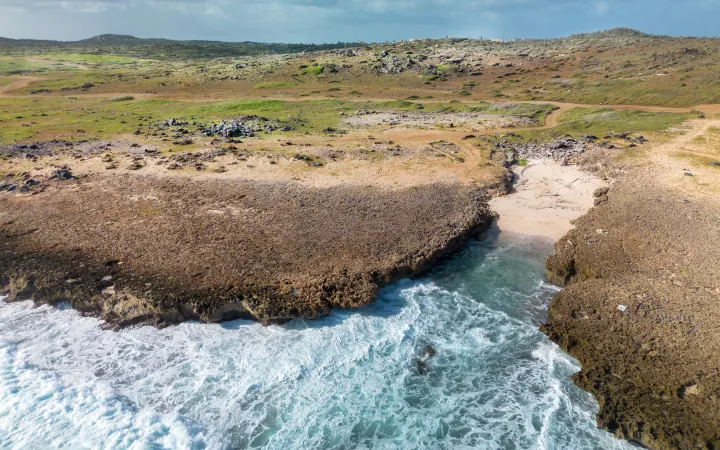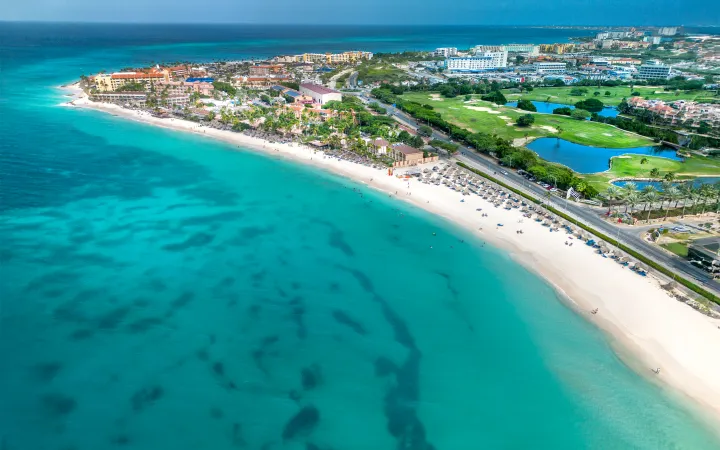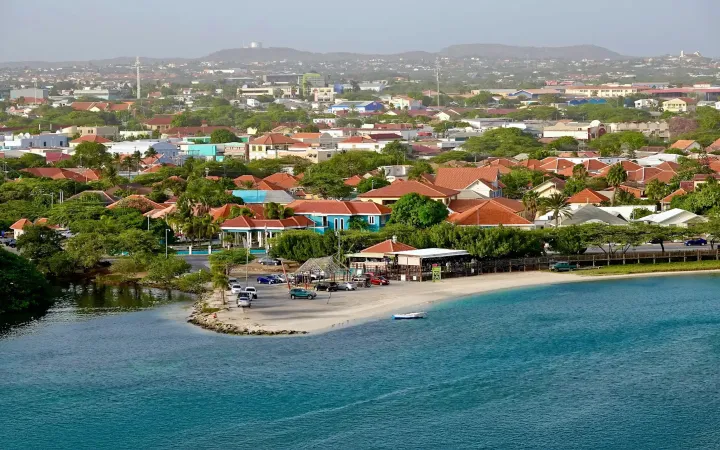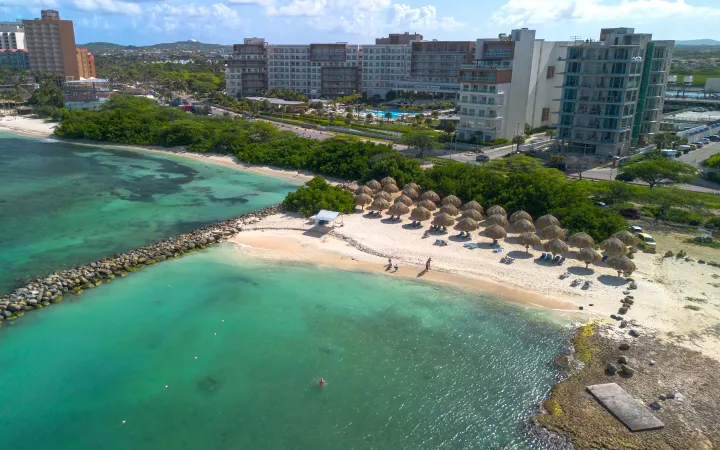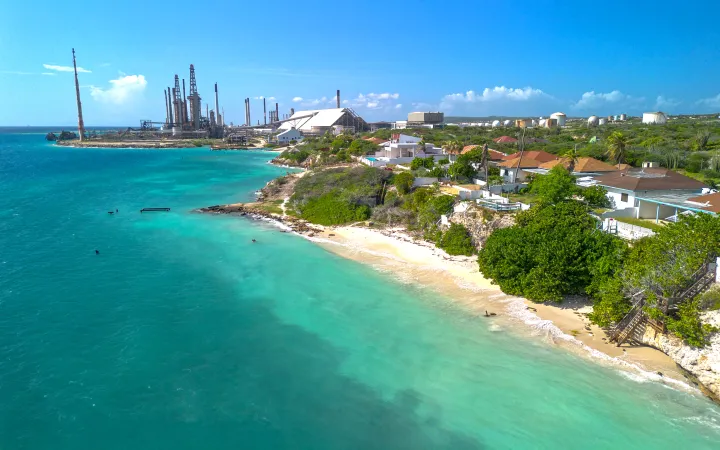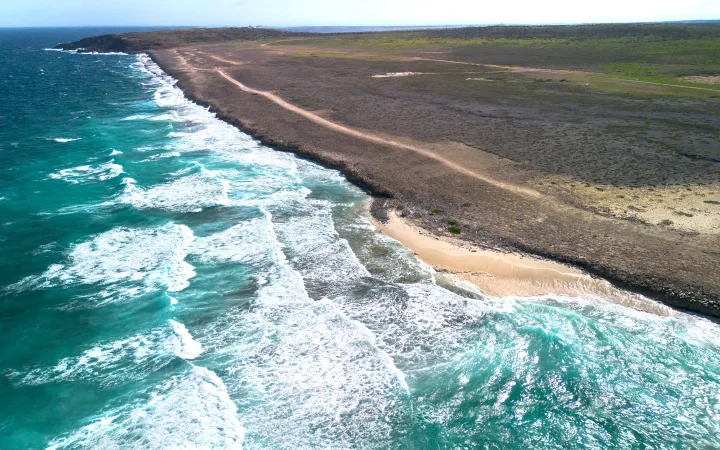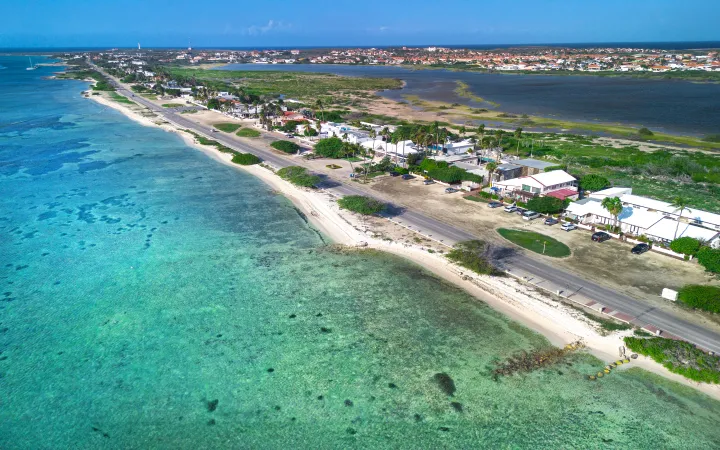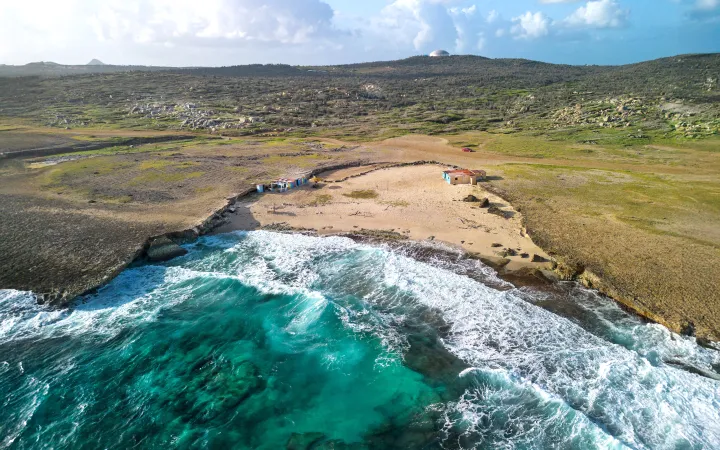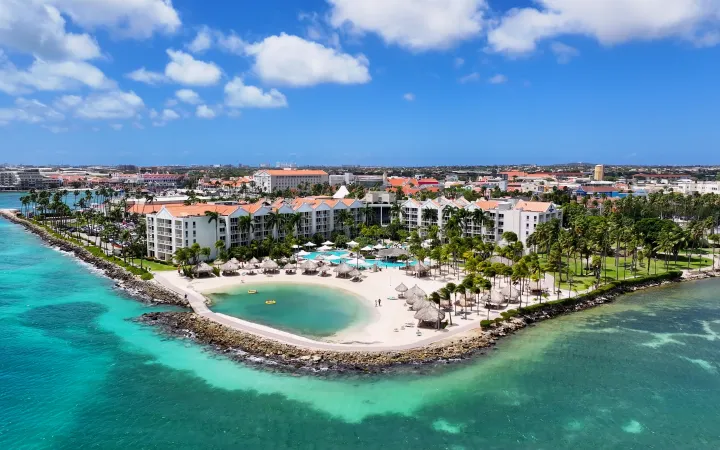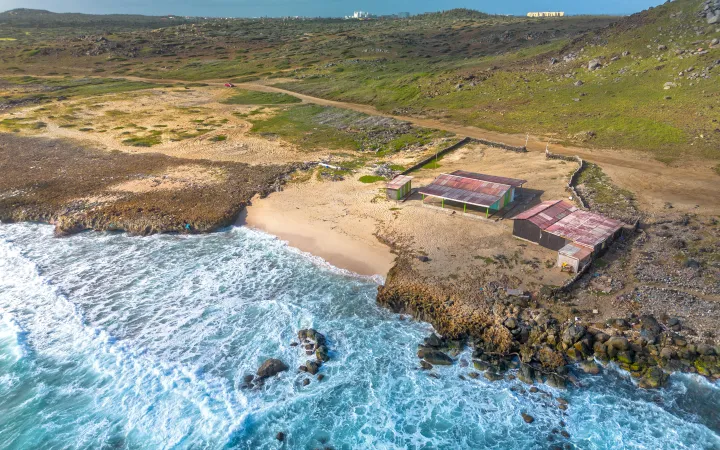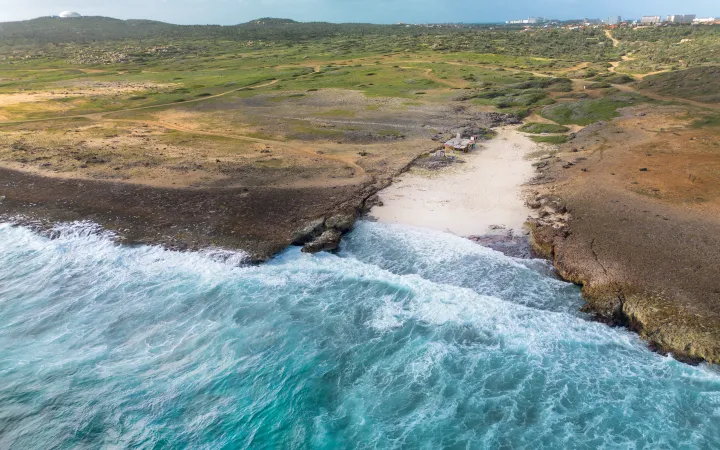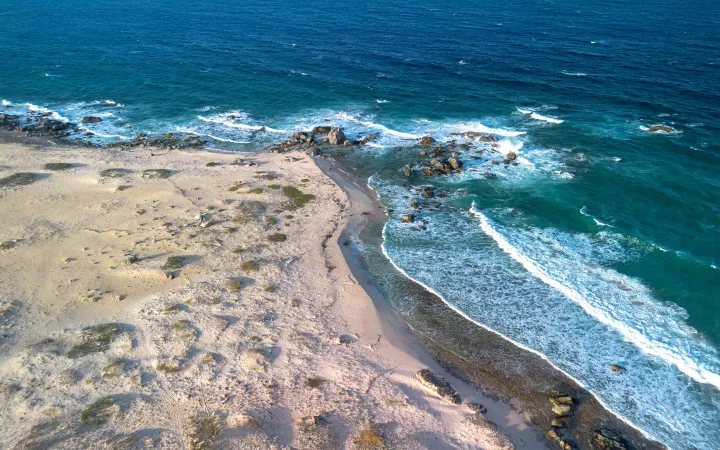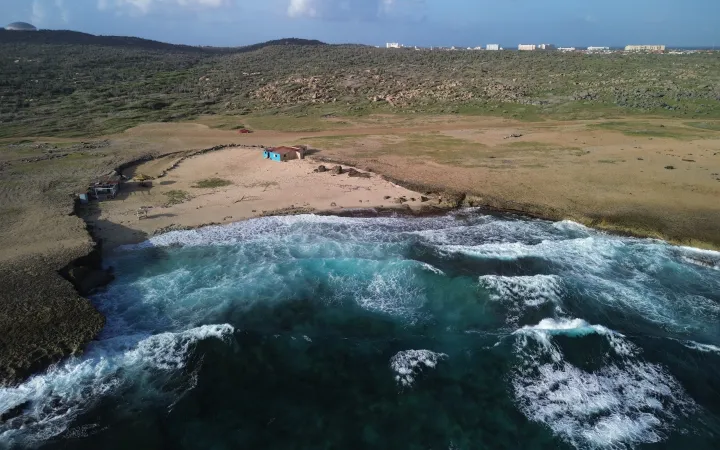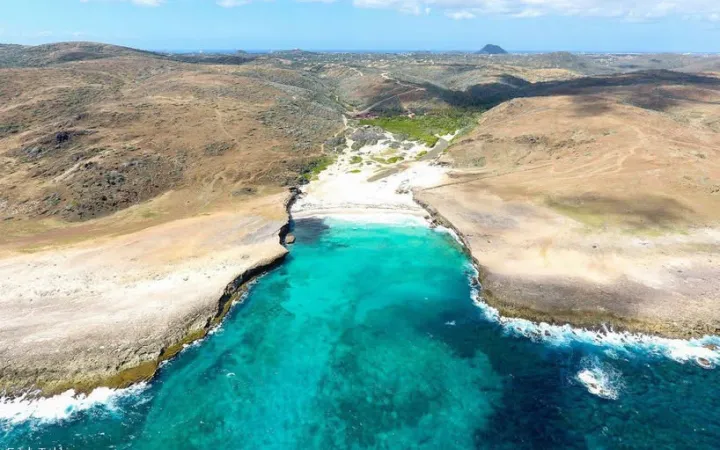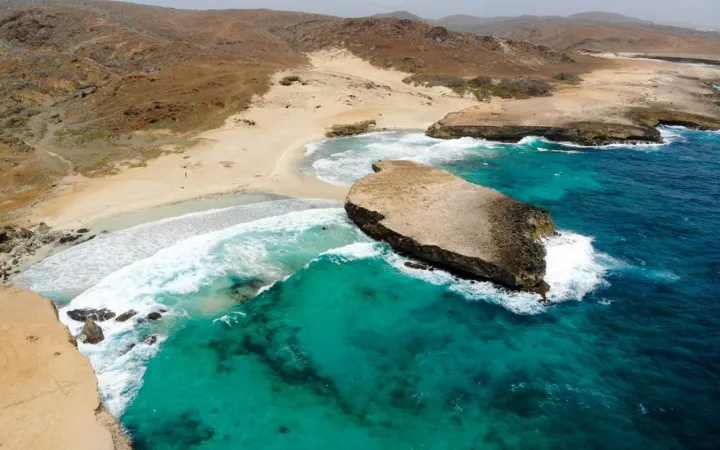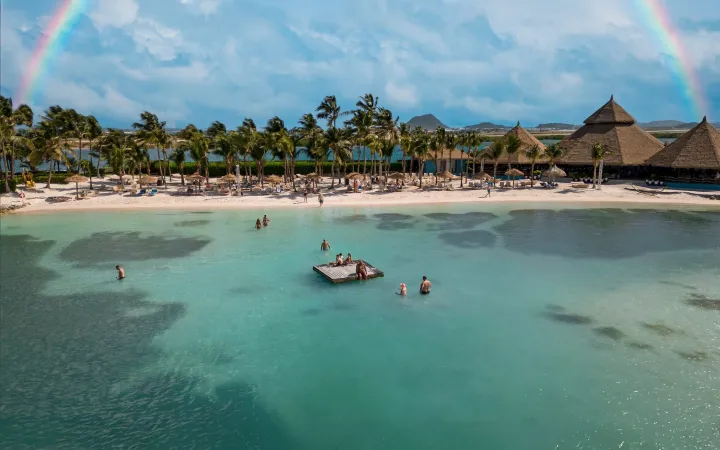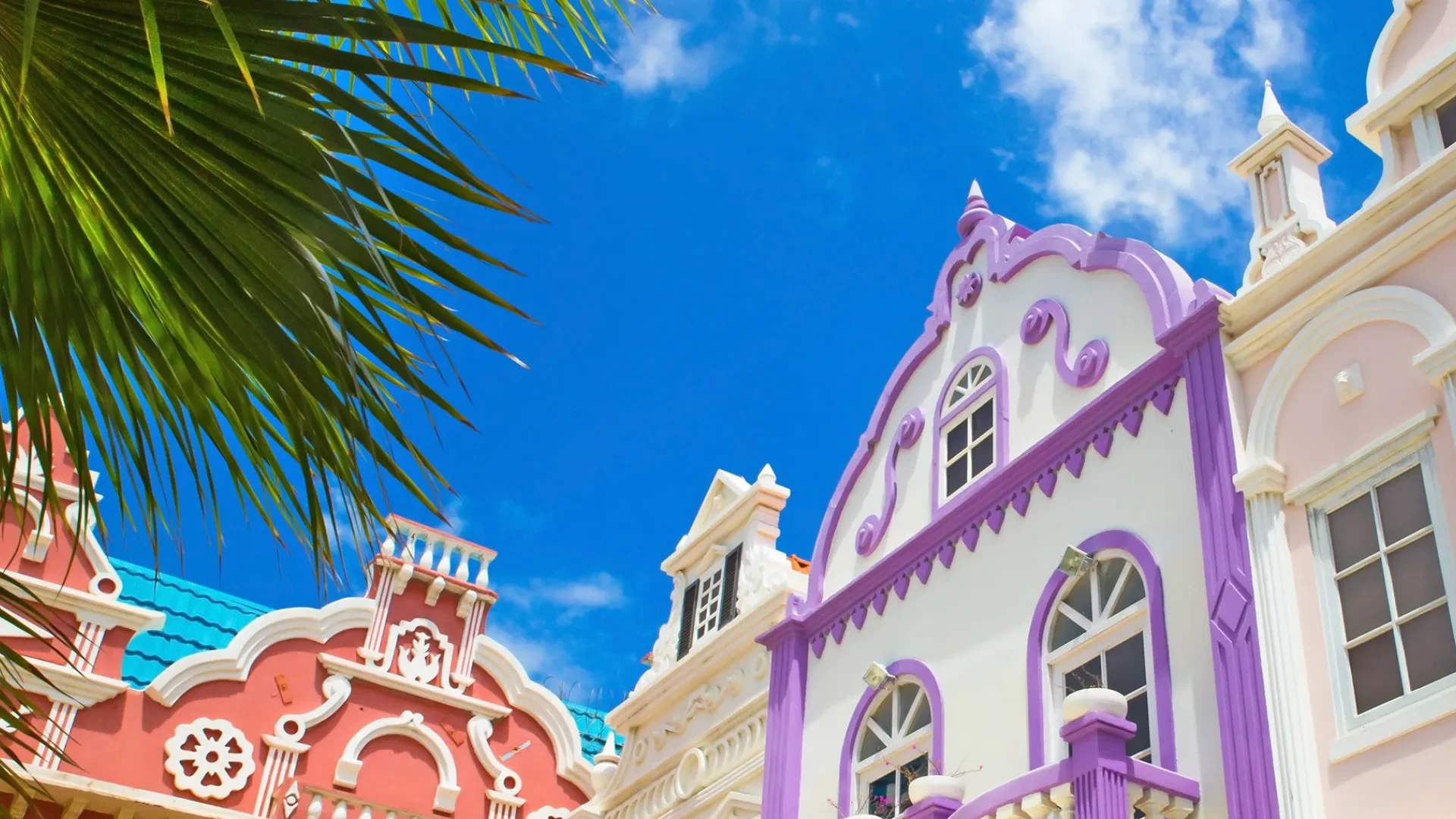
Tours • Attractions • Itineraries • Blog • Tips
Best things to do in Aruba: From sightseeing to excursions
Aruba travel blog
Aruba Queen Beatrix Airport: Gateway To Paradise
10 Best Books Set In Aruba From Local & International Authors
Aruba Queen Beatrix Airport: Gateway To Paradise
10 Best Books Set In Aruba From Local & International Authors
Things to see in Aruba
Beaches
Eagle Beach
Eagle Beach is often voted one of the world’s best beaches, thanks to its wide stretch of soft white sand and calm turquoise water. With fofoti trees, gentle surf, seasonal turtle nests and a relaxed low-rise vibe, Eagle Beach is perfect for slow days that still feel special.
Palm Beach
Palm Beach is one of Aruba’s most iconic stretches of sand, known for its turquoise, calm waters, palm-fringed shore, and bustling resort strip. Located on Aruba’s northwest coast, it’s a hub of beach life, watersports, and nightly entertainment. Whether you’re after relaxation or activity, Palm Beach delivers a vibrant Caribbean beach experience.
Baby Beach
This sheltered man-made lagoon is located on the southeast end of the island and is popular among both tourists and locals. The shallow and calm water makes it safe for small children and everyone new to snorkeling. Squids, parrot fish, blowfish, angelfish and eels are all among the usual residents of the lagoon.
Dos Playa Beach
Nestled inside Aruba’s Arikok National Park, Dos Playa Beach features two rugged coves carved from limestone, pounding surf, and zero development — just nature in its rawest form. If you’re willing to trade calm water for scenery, Dos Playa delivers something very special.
Andicuri Beach
Andicuri Beach Aruba is one of the island’s most rugged escapes, hidden between limestone cliffs and crashing surf. Unlike the calm west-coast beaches, this wild cove feels remote and uncrowded, with bodyboarders riding waves instead of swimmers. Getting here is part of the adventure, but that’s exactly why I love it.
Blackstone Beach
Aruba is famous for its pristine beaches, turquoise waters, and spectacular sunsets. But did you know that it also boasts a unique "black sand" beach that offers a stunning contrast to the island's white sand beaches? We are talking about of course the Aruba's Blackstone Beach that is made of small eroded stones. Here's how to plan your visit.
Boca Catalina
Boca Catalina in Aruba is that calm, hidden-gem beach that feels like your own slice of paradise. Located just north of Palm Beach in the Malmok area, Boca Catalina offers gentle snorkeling, white sand, and tranquil mornings. If you're looking to escape the crowds without sacrificing natural beauty or marine life, this beach should be high on your list.
Arashi Beach
Arashi Beach Aruba is where I go when I want soft white sand, reef snorkeling close by, and a break from the big resort crowds. Located just past Malmok and under the California Lighthouse, this beach is perfect for relaxing swims and colorful underwater life. In this guide, I’ll show you the best times to visit, what to bring, things to do, and how to get there hassle-free.
Boca Prins
Boca Prins is one of the most dramatic and wild beaches on the northeast coast of Aruba, tucked into Arikok National Park. It’s not a spot for casual swimming, but for nature lovers, photographers, and those craving solitude, Boca Prins Aruba delivers in spades. In this travel guide, I’ll show you how to safely explore it, what else to do and see nearby, and everything else you need to make the most of your visit.
Druif Beach
Druif Beach Aruba is a wide, sandy stretch just south of Eagle Beach, known mostly for its calm vibe and resort setting. It’s a beach close to Oranjestad, making it easy to reach, but there’s really not much here beyond the sand, sea, and a few low-rise hotels. If you’re looking for pure relaxation without distractions, this is the spot. Beware! There are two beaches in Aruba named Druif Beach and they are completely different.
Hadicurari Beach
Hadicurari Beach is famed as the island’s windsurfing and kitesurfing mecca, where colorful sails dance across aquamarine water. Nestled north of the Palm Beach zone, it offers a more relaxed, sporty alternative to Aruba’s high-rise coast.
Malmok Beach
Malmok Beach is a fantastic beach tucked along the limestone coast just north of Palm Beach. With calm, clear waters and excellent snorkeling right off the shore, it’s perfect for a relaxed half-day escape, and the many villas dotting Malmok Beach make it an excellent stay.
Mangel Halto Beach
Mangel Halto Beach is the kind of place you hear about from locals, not brochures. Mangroves frame a calm lagoon, the reef just offshore is packed with fish, and the vibe is as far from the resort strip as you can get. Here’s my personal travel guide to Mangel Halto Beach Aruba with tips on snorkeling, places to eat, and where to stay nearby.
Rodger's Beach
Rodger's Beach is a gem west of Baby Beach in San Nicolas, known for its powdery white sand, calm turquoise waters, and more authentic, local vibe with fishermen’s boat and softly lapping waves. While it’s not as developed or as busy as some of Aruba's main beaches, Rodgers Beach offers everything you need for a relaxed, memorable beach day.
Surfside Beach
Surfside Beach is my go-to when I want an easy beach day close to town. Just a 15-minute walk from the cruise port, it’s a calm, shallow stretch with plenty of shade, beach bars, and even plane-spotting as jets glide in over the water. If you’re visiting with kids or on a tight schedule, Surfside is a stress-free win.
Grapefield Beach
Grapefield Beach Aruba is one of the island’s most off-the-beaten-path beaches, tucked along the wild southeastern coast near San Nicolás. Unlike the polished resort beaches, Grapefield feels raw and otherworldly, with soft sand and windswept dunes. When I visited, the scene was surreal — abandoned shacks, stray dogs, and an eerie emptiness that made the place unforgettable.
Flamingo Beach
Flamingo Beach is Aruba’s most iconic spot, home to the famous pink flamingos that wander freely along the sand posing for Instagram. Located on the Renaissance Island just off Oranjestad, it’s a bucket-list experience whether you’re staying at the Renaissance Resort or lucky enough to snag a day pass. While some visitors say it’s pricey and can get crowded, I still think Flamingo Beach is one of those “must-do once in your life” Aruba experiences.
Manchebo Beach
Manchebo Beach is a gem tucked at the western edge of Aruba’s famed Eagle Beach with powder-white sands, gentle turquoise waters, and a wellness-focused ambiance. Because the area has relatively low development compared to Palm Beach, many visitors describe Manchebo as a quieter alternative — ideal for couples, honeymooners, or anyone seeking calm without giving up convenience.
Wariruri Beach
Wariruri Beach Aruba, also called Wariruri Bay, is one of the more notable stops along the island’s northeast coast. Unlike the tiny rocky coves nearby, Wariruri is wider, framed by limestone cliffs, and features a small natural bridge carved by the waves. It’s not suitable for swimming or snorkeling, but many visitors stop here while off-roading or hiking the rugged coastline.
Bushiri Beach
Bushiri Beach Aruba sits quietly between Oranjestad and Eagle Beach, right where the bustle of town starts to fade into a more relaxed stretch of sand. Unlike Aruba’s resort-lined beaches, Bushiri feels more local and low-key, with a mix of soft sand and rocky edges that give it character.
Savaneta Beach
Savaneta Beach in Aruba is a hidden gem tucked along the southern coast near Commandeurs Baai, offering a peaceful respite from the island’s busier shores. With calm, shallow waters and scenic views, it’s a great spot for relaxation and gentle exploration.
Cura Cabai Beach
Cura Cabai Beach in Aruba is a quiet escape on the island’s rugged southern coast. This hidden gem is gaining popularity thanks to Battata Beach Bar, which brings a lively yet relaxed atmosphere right on the sand. It's one of the most laid-back beaches in Aruba, far from the tourist crowds, although with a short list of activities.
Bachelor's Beach
Bachelor’s Beach isn’t the kind of place you see on postcards. Past San Nicolas, the sand is windswept, the water is too rough to swim, and most days you won’t meet a single person. That’s exactly why I stopped here, to see a different, wilder side of Aruba — full of garbage.
Tres Trapi Beach
Tres Trapi Beach Aruba is a tiny limestone cove with ridiculously clear water and a knack for snorkeling with turtles. Set between Malmok and Boca Catalina, it’s an easy hop from Palm Beach and Oranjestad. Come early with your own shade and snorkel gear, slip down the rock steps, and fin to the buoy line. It’s a quick, unforgettable stop — especially if turtles are on your list.
Boca Grandi
Boca Grandi is Aruba’s wild, wind-kissed edge—where kiters soar and the dunes meet open sea. I come here to watch the show, not to swim: the currents are strong and this isn’t a snorkeling spot. Think long walks, Red Anchor photos, and a quick hop to Baby Beach when you’re ready for calm water. If you want a raw, untamed coastline, Boca Grandi Aruba delivers.
Conch Shell Beach
Conch Shell Beach Aruba is a quiet escape on Aruba’s rugged north coast, where thousands of conch shells line the shore and pelicans glide just offshore. In this travel guide, I share what to expect, my best tips, and the top snorkeling, eats, stays & sights near this hidden gem.
Beach di Fossil
Beach di Fossil is probably Aruba's most off-the-beaten-path beach. A tiny, hidden stretch of coast at the far end of Grapefield Beach, scattered with dead fan corals and pounded by the waves. It’s not a place for swimming or snorkeling, but if you love wild landscapes, solitude, and raw beauty, this spot delivers.
Didi Beach
Didi Beach is one of those insignificant coves on the northeast coast of Aruba. There’s no swimming, no snorkeling, and no shade, just waves crashing into the rocks and debris washed ashore. There is absolutely no reason to visit it.
Divi Beach
Divi Beach Aruba is a beautiful stretch of white sand shoreline in Aruba’s low-rise hotel area, known for its calm turquoise waters, white sand and laid-back charm. It offers a relaxing yet activity-packed beach experience, without the bustle of Palm or Eagle Beach’s high rises. In this guide, I’ll walk you through everything you need for a perfect visit to Divi Beach Aruba — from snorkeling spots and things to do to where to eat, best hotels, and how to get there.
Gordo's Beach
Although all beaches in Aruba are public by law, Gordo's Beach is inaccessible by land and requires military permission to enter. With no snorkeling, no shade, and little more than scattered rubbish on the sand, Gordo’s Beach is more of a curiosity on Google Maps than a destination for travelers.
Governor's Bay Beach
Governor’s Bay Beach belongs is a small, calm cove just beyond Wilhelmina Park with the West Deck beach restaurant set directly on the sand. It’s perfect when you want clear water without leaving downtown — think cruise-day swim, lazy lunch, and sunset.
Juanita Beach
Juanita Beach is a small hidden spot that most visitors overlook, but that’s exactly what makes it special. Tucked away from the big resort crowds, it’s a quiet place to swim, watch the sunset, or simply relax under the shade. And should you crave more action, Palm Beach is just arund the corner.
Nanki Beach
Nanki Beach is one of Aruba’s best-kept secrets, nestled between Rodger's Beach and the island’s oil refinery on the southern coast near San Nicolás. This secluded cove offers an offbeat escape for couples and adventurers who crave quiet over crowds. With rugged cliffs, minimal shade, and a raw natural charm, Nanki Beach Aruba is for those willing to venture slightly off the beaten path to find true solitude.
Surfers Beach
Surfers Beach, formerly known as Plastic Beach, is one of Aruba’s most desolate spots. South of Bachelor’s Beach, this small stretch of sand is rough, debris-strewn, and unsafe for swimming due to strong currents and big waves. There are no facilities or shade, but the dramatic coastal walk along the Seroe Colorado plateau makes it worth a stop if you enjoy wild landscapes.
Playa de Blanca
Playa de Blanca is technically a section of Malmok Beach but many people consider it an independent beach. Playa de Blanca is popular among snorkelers and people looking to do some beach combing. With clear shallow waters and a sunken ship, it’s ideal for both casual swimmers and underwater explorers.
Ranchero Curason Beach
Ranchero Curason Beach is another one of Aruba’s insignificant northeast coast coves. It’s a bit wider than nearby Didi Beach, with an old abandoned shack and a single umbrella as the only signs of human presence. There’s no swimming, no snorkeling, and no real shade — just waves crashing into the rocks and sand that often collects debris.
Renaissance Beach
Renaissance Beach is the small, man-made lagoon tucked beside Queen Wilhelmina Park in Oranjestad. Unlike the famous Renaissance Island with its flamingos, this beach belongs to the Renaissance Aruba Resort & Casino’s Ocean Suites and offers calm, rock-protected waters right in the city. It’s a handy spot to cool off, enjoy the harbor views, or unwind without leaving downtown.
Shack Beach
Aruba Shack Beach is one of those tiny, forgotten spots on Aruba’s northeast coast. The beach itself is little more than a sandy patch with an abandoned shack nearby. There’s no swimming, no snorkeling, and no facilities, just rough waves and a harsh, windy coastline.
Urirama Beach
Urirama Beach is one of the most insignificant beaches on Aruba’s northeast coast. The area is isolated, with an abandoned shack and piles of garbage often washed ashore. There’s no swimming, no snorkeling, and no facilities — just rough waves and a desolate feel.
Westpunt Beach
At Aruba’s far northern tip, Westpunt Beach shows the island’s wild side. Strong winds, crashing waves, and a rugged coastline make it very different from the calm resort beaches. It’s not great for swimming, but it’s perfect if you enjoy kitesurfing, hiking, or simply taking in dramatic ocean views.
Klif Beach
Klif Beach is another forgotten cove on Aruba’s northeast coast. The area is harsh and undeveloped, with strong waves, sharp rocks, and an abandoned shack as the only sign of human presence. Garbage often washes ashore, making it even less appealing. There’s no swimming, no snorkeling, and no facilities of any kind.
Lince's Cove
Lince’s Cove is a small, rocky beach on the Aruba’s northeast coast, located right next to Pearl Cove. It’s a little wider than its neighbor, but still has the same rough waves, scattered debris, and complete lack of facilities. There’s no safe swimming or snorkeling here.
Pearl Cove
Pearl Cove is the tiniest of all the northeast coast coves in Aruba. It’s barely more than a sandy pocket carved into the rocks, with no shack, no shade, and no facilities. Like the other coves along this stretch of coastline, the waves are rough outside the cove, and debris often washes ashore. There’s nothing here except the novelty of standing at Aruba’s smallest, most hidden beach.
Red Fish Cove
Red Fish Cove is more of a natural curiosity than a real beach destination. With no facilities and a rugged setting, it’s not the kind of place most travelers will visit. Its charm lies in its size — a tiny sliver of sand where you can feel completely alone, surrounded by waves crashing outside the cove.
Stone Fish Cove
Stone Fish Cove is one of the tiny coves hidden along the island’s northeast coast, tucked between Red Fish Cove and Hyro’s Cove. Unlike the others, this spot barely has any sand — it’s mostly boulders and rocks with rough waves pounding the shore. There’s no swimming, no snorkeling, and no facilities, but if you’re hiking or off-roading between the Natural Bridge and Andicuri, it makes for a quick curiosity stop.
Picnic Cove
Picnic Cove Aruba is one of the tiny coves scattered along the island’s northeast coast, located between the Natural Bridge and Hyro’s Cove. The beach itself has very little sand, mostly rocks and rough surf, so it’s not a place for swimming or snorkeling. With no shade or facilities, it’s best seen as a quick stop while exploring the Natural Bridge area or hiking the coastline.
Shark Bay Beach
Shark Bay Beach is a wide, rugged beach framed by cliffs and rough surf. It looks dramatic but isn’t a place for water activities or relaxing. The lack of facilities, shade, and calm water make it unsuitable for a beach day. Most visitors only pass by as part of a hike along the coast or during a trip to Andicuri and Natural Bridge.
Daimari Beach
Daimari Beach is one of Aruba’s more rugged, hidden gems, tucked away in Arikok National Park on the island’s northern coast. If you’re craving solitude, dramatic cliffs, and nature unspoiled by crowds, this is the spot. Expect crashing waves rather than calm lagoons, and bring a spirit of adventure — this beach isn’t about luxury, but about raw beauty, wind, and wide-open skies.
Boca Keto
I’ve always been drawn to the edges of maps, and Boca Keto in Aruba is one of those spots that pulls you off the beaten path. This secluded beach inside Arikok National Park is known for crashing waves, jaw-dropping rock formations, and visceral ocean views. If you’re craving raw coastal beauty and a quiet beach day far from crowds, Boca Keto may just steal your heart.
Hyro's Cove
Hyro’s Cove is a small indentation in Aruba’s rugged limestone coast. It’s one of the least significant beaches on the island, with nothing to do and no safe access to the water. Most visitors only pass by if they’re driving the northeast coast by jeep, barely even noticing that there is a beach kind of thing here.
Iguana Beach
Iguana Beach is a tranquil, family-friendly beach located on the private Renaissance Island, just off Oranjestad. It's one of the two beaches on the island and this one is known for its resident iguanas, shade, cabanas, and easy access (via the resort’s boat). As part of a private island experience paired with Flamingo Beach, Iguana Beach offers a quieter counterpoint to the flamingo-crowd.
Aruba travel advisory
Aruba good to know before traveling
Aruba travel videos

Holiday in Aruba: Everything you need to know
Aruba, a jewel in the Caribbean Sea, is more than just a sun-soaked beach destination; it's an island teeming with vibrant culture, hidden treasures, and breathtaking natural wonders. Whether you're planning a relaxing getaway or an adventure-packed holiday, the free Aruba travel guide insights will illuminate the island’s unique charm and why it deserves a top spot on your travel bucket list.
All-year-round perfect weather makes Aruba or ‘One happy island’ how many call it, the ideal tropical destination for a winter holiday. The cactus-strewn landscape with countless natural wonders, rugged windswept vistas and powdery white sand beaches combined with the Dutch influence creates a truly vibrant and unique atmosphere.
Explore the natural wonders of Arikok National Par such as the Natural Pool, Ayo and Casibari Rock Formations and natural bridges. You will find some of the most picturesque beaches of the Caribbean here like Eagle Beach, Palm Beach and Baby Beach. Don’t miss out on San Nicolas, a quaint little town, where you’ll find amazing new street murals and Charlie’s Bar, a charming little bar. There’s plenty of family-friendly activities to do as well: pay a visit to the Butterfly Farm, Philip’s Animal Garden, Donkey Sanctuary or the Ostrich Farm.
Ready to uncover all that Aruba has to offer? Continue reading our step-by-step Aruba travel guide to find out more about the best attractions, excursions, restaurants, and essential tips for planning your unforgettable trip. Your dream vacation awaits!
Aruba Tourism Info: Things to Know Before Traveling
It's great that you've decided to travel to Aruba! Now you just need a comprehensive travel guide to plan your trip to this Caribbean island. This is a complete Aruba travel guide with insider tips, where you'll find answers to the most common questions and essential tips.
This step-by-step Aruba travel planner will help you create the perfect trip, covering everything from must-see attractions and exciting excursions to top-notch restaurants and crucial travel information. Get ready to explore and enjoy all that Aruba has to offer thanks to our free online travel guide!
Essential Aruba Travel Information
First things first, there are a few things to know before traveling to Aruba to ensure you plan your trip accordingly. For the best Aruba travel advice, our guide provides essential Aruba tourist info:
- Passport: Ensure your passport is valid for at least six months beyond your travel dates. No visa is required for U.S. citizens for stays up to 30 days.
- Currency: The Aruban Florin (AWG) is the official currency, but U.S. dollars are widely accepted. Credit cards are commonly used.
- Language: Dutch and Papiamento are official languages, but English and Spanish are widely spoken.
- Weather: Aruba has a tropical climate with warm temperatures year-round and is outside the hurricane belt.
- Health and Safety: Aruba is one of the safest Caribbean islands. Practice common travel safety measures.
- Transportation: Renting a car is convenient. Taxis have fixed rates, and public buses are affordable.
- Electricity: Uses 110V and Type A/B plugs, same as the U.S.
- Water Quality: Tap water is safe to drink.
- Local Customs: Dress modestly at religious sites and ask permission before photographing locals.
- Time Zone: Atlantic Standard Time (AST) year-round, no daylight saving time.
- Tipping: Customary; service charges are often included in restaurant bills.
- Emergency Numbers: Dial 911 for police, fire, and medical emergencies.
- Travel Insurance: Recommended for covering unexpected events like medical emergencies or trip cancellations.
Read our comprehensive guide on Aruba travel tips to learn more about the island's customs. We have also collected a few Aruba fun facts to show you its uniqueness.
Top 10 Reasons to Visit Aruba: A Bucketlist Destination
Aruba is the ideal Caribbean getaway, offering everything from beautiful beaches to vibrant nightlife. Here are the top 10 reasons why Aruba should be your next travel destination:
1. Gorgeous White-Sand Beaches
Eagle Beach and Palm Beach are famous for their powdery sand and crystal-clear waters, making Aruba a top spot for sunbathing, swimming, and water sports.
2. Year-Round Perfect Weather
With average temperatures around 82°F (28°C) and consistent trade winds, Aruba’s sunny, dry climate is perfect for a tropical vacation any time of the year.
3. Outdoor Adventures
From snorkeling and diving to windsurfing and jeep tours in Arikok National Park with a knowledgeable Aruba tour guide, Aruba offers diverse outdoor activities for thrill-seekers.
4. Rich Cultural Experiences
Enjoy the island's unique blend of Caribbean, Dutch, and Latin influences through music, dance, colorful architecture, and lively festivals like Carnival.
5. Delicious Food Scene
Savor fresh seafood, local Aruban dishes, and international cuisine at beachside restaurants or during food festivals. Aruba's culinary offerings are sure to delight.
6. Luxurious Accommodations
From all-inclusive resorts to boutique hotels and private villas, Aruba has lodging options to fit every taste and budget, often with beachfront access.
7. Lively Nightlife
Experience Aruba's vibrant nightlife with beach bars, casinos, nightclubs, and live music, making it perfect for those who want to party after the sun goes down.
8. Safe and Family-Friendly
Known for its low crime rate and welcoming atmosphere, Aruba is a safe and friendly destination for families and solo travelers alike.
9. Commitment to Eco-Tourism
Explore natural wonders in Arikok National Park, visit the Butterfly Farm, or see wildlife at the Aruba Ostrich Farm, highlighting Aruba’s dedication to sustainability.
10. Easy Access and Convenience
With direct flights from major cities, widespread English-speaking locals, U.S. dollar acceptance, and modern infrastructure, traveling to Aruba is convenient and hassle-free.
Aruba Travel Planner: Experience the Culture, Visit Famous Landmarks and Discover Hidden Gems
Aruba's culture is a fascinating blend of indigenous heritage, Dutch influence, and Caribbean flair. This unique cultural mosaic is reflected in everything from the island's colorful festivals to its delicious cuisine. Beyond the popular tourist attractions, the island is home to many hidden gems that offer a more intimate experience of the island’s beauty as outlined in this Aruba travel guide for first-time visitors.
Experience the Warmth of Aruban Hospitality
Arubans are known for their warmth and friendliness, often greeting visitors with a smile and a heartfelt "Bon Bini!"—meaning "Welcome" in Papiamento, the local language. Whether you're exploring local markets or dining at a family-owned restaurant, the island’s hospitality will make you feel right at home. Hiring a local Aruba island guide is a great way to see the hidden secrets of this tropical paradise often undiscovered by tourists and have a personalized experience.
Dive into Local Traditions and Festivals
Aruba's cultural calendar is packed with events that offer a window into the island’s soul. From the vibrant parades of the Carnival season to the Dera Gai festival, which celebrates the island's agricultural heritage, there's always a reason to celebrate in Aruba. Participating in these events allows travelers to connect with the island on a deeper level, making your visit more than just a typical beach vacation.
Explore Off-the-Beaten-Path Beaches
While Eagle Beach and Palm Beach are renowned for their beauty, Aruba boasts several lesser-known beaches that are just as stunning. Baby Beach, located on the island's southern tip, is a local favorite with its calm, shallow waters perfect for snorkeling. For those seeking solitude, Mangel Halto offers a secluded cove surrounded by mangroves, ideal for a peaceful day by the sea.
Unveil the Island’s Natural Wonders
Aruba's natural landscape is as diverse as it is beautiful. The rugged terrain of Arikok National Park covers nearly 20% of the island and is a must-visit for nature lovers. Here, you can hike through cactus-studded trails, explore ancient cave paintings, and marvel at the island’s unique flora and fauna. Don’t miss the natural pool, a secluded swimming spot surrounded by volcanic rock formations, offering a refreshing escape from the tropical heat.
Discover Aruba's Marine Life
Aruba’s crystal-clear waters are home to a vibrant underwater world, making it a top destination for snorkeling and diving. The island’s coral reefs and shipwrecks, like the famous Antilla wreck, are teeming with colorful fish, sea turtles, and other marine creatures. For an unforgettable experience, consider a night dive to witness the nocturnal activities of the ocean’s inhabitants.
Finding the perfect snorkeling spots in Aruba can make your vacation even more memorable. Eagle Beach and Arashi Beach are two must-visit locations, known for their crystal-clear waters and abundant marine life. Boca Catalina is another excellent site, offering calm waters and vibrant coral reefs that are perfect for both beginners and experienced snorkelers. Don’t forget to check out Mangel Halto, which presents a more secluded and equally stunning snorkeling experience.
Relish in the Island's Scenic Views
For panoramic views of the island, head to the California Lighthouse, where you can take in stunning vistas of the coastline and the surrounding turquoise waters. The Hooiberg, a volcanic formation rising 541 feet above sea level, also offers a challenging hike with rewarding views at the summ
Aruba Travel Guide: Arrive As a Tourist, Leave As a Local
Aruba is a destination that caters to every type of traveler. Whether you’re looking for a romantic escape, a family vacation, or an adventurous retreat, our expert Aruba travel guide is your gateway to a truly unforgettable stay. This Aruba vacation information page surely covers all the things to know before going to Aruba.
